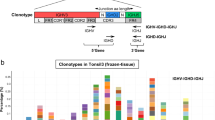Abstract
Virtually all immunoglobulin kappa (IGK) gene deletions are mediated via rearrangements of the so-called kappa deleting element (Kde). Kde rearrangements occur either to Vκ gene segments (Vκ–Kde rearrangements) or to the heptamer recombination signal sequence in the Jκ–Cκ intron. Kde rearrangements were analyzed by the polymerase chain reaction (PCR) and heteroduplex analysis in 130 B-lineage leukemias: 63 precursor-B-acute lymphoblastic leukemias (ALL) and 67 chronic B cell leukemias. To obtain detailed information about Kde rearrangements, we sequenced 109 of the 189 detected junctional regions. Vκ gene family usage in the Vκ–Kde rearrangements in our series of B-lineage leukemias was comparable to Vκ gene family usage in functional Vκ–Jκ rearrangements in normal and malignant mature B cells, except for a higher frequency of Vκ II family usage in precursor-B-ALL. Junctional region sequencing of the Kde rearrangements in precursor-B-ALL revealed a mean insertion of 4.7 nucleotides and a mean deletion of 9.5 nucleotides, resulting in an extensive junctional diversity, whereas in chronic B cell leukemias the insertion (1.9) and deletion (6.0) were significantly lower. The relatively extensive junctional diversity of the Kde rearrangements in precursor-B-ALL allowed us to design leukemia/patient-specific oligonucleotide probes, which were proven to be useful for detection of minimal residual disease (MRD) with sensitivities of 10−4 to 10−5. Kde rearrangements occur in approximately 50% of precursor-B-ALL cases and are likely to remain stable during the disease course, because Kde rearrangements are assumed to be ‘end-stage’ rearrangements, which cannot easily be replaced by continuing rearrangement processes. These findings indicate that junctional regions of Kde rearrangements in precursor-B-ALL represent new valuable patient-specific PCR targets for detection of MRD.
Similar content being viewed by others
Author information
Authors and Affiliations
Rights and permissions
About this article
Cite this article
Beishuizen, A., de Bruijn, M., Pongers-Willemse, M. et al. Heterogeneity in junctional regions of immunoglobulin kappa deleting element rearrangements in B cell leukemias: a new molecular target for detection of minimal residual disease. Leukemia 11, 2200–2207 (1997). https://doi.org/10.1038/sj.leu.2400904
Received:
Accepted:
Issue Date:
DOI: https://doi.org/10.1038/sj.leu.2400904
- Springer Nature Limited
Keywords
This article is cited by
-
Use of V(D)J recombination excision circles to identify T- and B-cell defects and to monitor the treatment in primary and acquired immunodeficiencies
Journal of Translational Medicine (2013)
-
IGH and IGK gene rearrangements as PCR targets for pediatric Burkitt's lymphoma and mature B-ALL MRD analysis
Laboratory Investigation (2009)
-
Implementation of the standard strategy for identification of Ig/TCR targets for minimal residual disease diagnostics in B-cell precursor ALL pediatric patients: Polish experience
Archivum Immunologiae et Therapiae Experimentalis (2008)
-
Minimal residual disease-directed risk stratification using real-time quantitative PCR analysis of immunoglobulin and T-cell receptor gene rearrangements in the international multicenter trial AIEOP-BFM ALL 2000 for childhood acute lymphoblastic leukemia
Leukemia (2008)
-
Human T-cell lines with well-defined T-cell receptor gene rearrangements as controls for the BIOMED-2 multiplex polymerase chain reaction tubes
Leukemia (2007)




